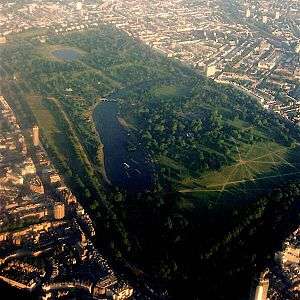Walpole Park
Walpole Park is a municipal urban public open space run by London Borough of Ealing Council. Its main entrance is situated in the Mattock Lane, Ealing, West London.
In 1987 it was registered by English Heritage on the Register of Parks and Gardens of Special Historic Interest in England.[1] It is some 28 acres (110,000 m2) in size. Within its boundaries are the Pitzhanger Manor museum & art gallery and Perceval Lodge. These buildings and part of the boundary wall are also statutory protected structures of Grade I and Grade II respectively.[2]
There is also a late Victorian ornamental lake bordering the House's rear lawn and further west a pond which has a pair of fountains, both of which attract waterfowl.
The land for the park and Pitzhanger Manor itself was acquired by the council in 1899 from Sir Spencer Walpole, which in turn had been bought by his father the Rt. Hon. Spencer Horatio Walpole. The sum paid was £40,000. It was opened to the public for the first time on 1 May 1901.[3]
Walpole is also a ward of the London Borough of Ealing. The population at the 2011 Census was 13,330.[4]
History


The original house, which stood here, and its grounds which make up the present park, was once the property of John Soane the architect, who bought it in 1800. After several more changes of ownership it was purchased by the Urban District Council of Ealing in 1900. The Borough surveyor Charles Jones who negotiated the terms of the sale with his close friend Sir Walpole also went on to set out the design of tree-lined avenues, paths and flower beds.[5] The outer path is nearly a mile in circumference. The sides of the pond nearest Pitzhanger Manor was planted with plants and shrubs and other stuff.
Soane's house then became the borough's central public lending library. The library vacated the site in 1984. Work then began on researching the building to discover the original décor and renovating it back to how it had been in Soane's day. A library extension that had been built on the north-side was converted into the present day art gallery and other stuff.
At the end of the 1980s some restoration work was done to recreate some of the original layout by Soane of the garden, which he had done with the help of John Haverfield.
The park was extensively renovated from August 2013 onwards and reopened fully in the summer of 2014. Two new ponds replaced the ornamental lake and the fishpond. Breeding wildfowl have returned to the park and the new flower beds are developing, with Regency planting. The bridge which was situated at one end of the sunken garden has been restored.
General description
Most of the park consists of open flat grassed areas bordered by tree lined avenues, which act as wind breaks. Of the two ponds, the western most was the larger of the two and was more formal. It also featured a fountain. The pond nearest to Pitzhanger Manor on the eastward side of the park had sunken sides, which were planted with a mixture of ornamental shrubs and bushes. The pond itself was made to look as though it was a small gently flowing brook. A contemporary drawing of the manor house in the museum suggests that, at the time of Soane, this pond was much deeper. It was from its sides that John Soane and his friend William Turner (the artist) would sit and fish. As the grounds to the west were pastoral it is quite possible that this pond was constructed as a Ha-ha against cattle and sheep. The bridge at the north end, and the pond, were in existence before Soane bought the property but he had it decorated to give an appearance of great antiquity, no doubt to match his faux Roman ruins which he built just to the north of his house. It is a listed Grade II* structure.
Along the north perimeter wall is a large stone bench. This also has a statutory protection of Grade II listed. Next to the bench is a memorial plaque dedicated to Charles Jones, an architect who lived in Ealing, designed its town hall, and served as the town's mayor.[6]
Perceval Lodge, which has already been mentioned, is used as an arts and crafts center.
Events

Each year in the summer months the park is an al fresco venue to the:
- Ealing Beer Festival (4 to 7 July) [7]
- Ealing Comedy Festival,[8]
- Ealing Opera in the Park,[8]
- Ealing Blues Festival,[8]
- Ealing Global Festival,[8]
- Ealing Jazz Festival.[8]
References
- ↑ English Heritage (2004-03-23). Register of parks and gardens of special historic interest in England. Urban Public Parks Reg. number 1843. Accessed 2008-04-22.
- ↑ Ealing’s New Plan for the Environment, volume 2, Chapter 10.9 Statutory Listed Buildings and Ancient Monuments. The statutory List of Buildings of Special Architectural or Historic Interest prepared by the Department of the Environment. Accessed 2008-04-19
- ↑ Neaves, Cyrill (1971). A history of Greater Ealing. United Kingdom: S. R. Publishers. pp. 65, 66. ISBN 0-85409-679-5.
- ↑ "Ealing Ward population 2011". Neighbourhood Statistics. Office for National Statistics. Retrieved 21 October 2016.
- ↑ McEwan, Kate (1983). Ealing Walkabout: Journeys into the history of a London borough. Cheshire, UK.: Nick Wheatly Associates. p. 45. ISBN 0-9508895-0-4.
- ↑ "Charles Jones (1830-1914)". Victorian Web. Retrieved 18 February 2015.
- ↑ West Middlesex CAMRA.Ealing Beer Festival. Accessed 2012-04-26
- 1 2 3 4 5 Ealing Council. . Accessed 2011-07-04
Further reading
- Leary, Emmeline. Pitshanger Manor: An Introduction. New ed. [Ealing, London]: Ealing Community Services, [1990].Pages 18–27. ISBN 0-86192-090-2. The booklet now (early 2008) sold in the Manor as a guide and souvenir. Although the publication is not dated, the short introduction is dated January 1990 and is clearly written for publication.
Coordinates: 51°30′39.95″N 00°18′26.02″W / 51.5110972°N 0.3072278°W

